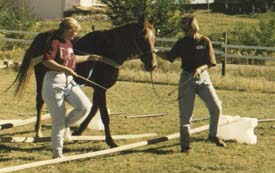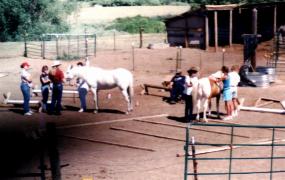TTeam & TTouch philosophy:
To respect each animal as an individual.
To honor the role of animals as our teachers.
To bring awareness to the importance of animals in our lives.
To recognize the individual learning process of every human and animal.
To encourage harmony, cooperation and trust between humans and animals as well as amongst humans.
That most resistance comes from tension, discomfort or pain in the horses body or lack of balance (physical, mental and emotional).
~~~~~~~~~~~~
Increases attention, obedience, self-control, self-confidence, coordination, balance, and focus
Enables greater range of motion (especially useful in older equines)
Corrects behavioral problems
Reduces tension; fear; and pain (resulting from illness and/or competitive stress)
Helps Cope with episodes of stress, injury and colic
Improves performance and condition
Aids horses in understanding of training sessions
Corrects specific riding tendencies (dropping inside shoulder, stumbling, short striding, etc.)

The body wrap.
~~~~~~~~~~~~~
Some of the Tools
Wand (Dressage whip) - A 4' dressage whip with 3" tassel. This is called a 'wand' because of the way it is used. It also keeps you aware of the difference between a communication tool and a whip. The wand is used to guide the horse through ground and riding exercises, as an initial contact medium between horse and human and as a cue re-enforcer.

Rope neck ring - A riding aid for bridleless riding. The neck ring provides guidance to the horse.
Balance rein - A riding aid. The balance rein helps the horse rebalance during riding exercises by influencing the neck and head carriage.
Promise Rope - A small diameter rope, attached to the saddle and running loosely behind the hindquarters, above the hocks. It is used to 'promise' forward movement.
Driving lines - Long lines used to educate the young horse or re-educate an older horse to riding cues. Initially used as a single set tied around chest to withers and in conjunction with a second person leading. This allows the transfer of cues from the lead (on the halter) to the lines. A second set of lines can be added, attached to the halter or headstall / bit to facilitate learning bit cues.
Lindell - The lindell is a rope noseband headstall used in starting young horses. Many horses go quite well in the lindell and never require bitting.
Body wraps (Ace bandage or rope) - The wraps are placed on the horse in a figure eight pattern, around the neck and hindquarters, crossing just behind the withers. The body wrap is effective in working with horses that do not collect well, that have emotional stress or that have gait difficulties.

Leading under the tarp--preparation for trailer loading.

Riding thru the labyrinth.

Leading thru the uneven poles.

Linda Bertani riding a horse with a body wrap.

TTEAM Clinic at Raian's place.

Leading the horse with the body wrap over elevated poles.

Use of the balance rein--notice the difference in the horse's frame.
Photos courtesy of Raian Kaiser of 7 Acres Horse Training
The Facial Swirls article in June 1995 Western Horseman talks about analysing your horse's personality by his facial swirls. It is an excerpt from a Linda Tellington Jones book. Jones talks about the swirls on horses being like our fingerprints-no two just alike and certain breed association use them as identification marks. She has studied facial swirls since 1965 and has found the evaluations to hold true 70% of the time. She says you have to look at other things such as ears, eyes, mouth-not just swirls. Sometimes other characteristics will out weigh the swirl. The article explains several types of swirls and their meanings: (taken from article)
1. Single swirl between or above the eye is the standard on diplayed by the majority of horses in her studies. Indicates horse with generally uncompicated nature, but ther are variations. Swirls may be set to one side or the other. Swirls set to the left as you face the animal-horse will tend to be a touch more complicated but still trustworthy. Set to right may be less cooperative than those with center or let to left swirl. In general, swirls of this sort are less indicative of characher that the more complex patterns.
2. Single swirl several inches below the eyes-she found 80-% of horses with this are unusually imaginative and intelligent; like to amuse themselves-turn on water, open stall doors, untying complicated knots, find ways to escape pastures. These horses are usually of above average intelligence and are interesting characters to deal with.
3. A single long swirl that may be between the eyes or extend below: Indicates a horse who is friendly and particularly enjoys relating to people.
4. Two swirls adjoining, either one above the other or side by side: These can be above, between, or below the eyes and are sometimes set at an angle to each other. Horses with this tend to be more emotional and over-reactive than average. Tend to become upest without apparent reason, and at unexpected moments. When such horses blow up, the best way to handle them is to back off and allow them to settle. Punishing them doesn't help; in fact it usually only aggravates the behavior more and can even bring on more resistance. However, she says a horse like this can be a great horse-she has had some of her best show horses with this configuration but generally, horses with this pattern are not ideal for inexperience riders.
5. Three swirls close together on the forehead (not up under the forelock) Rare; In gelding and mares this indicates a complex individual but not an unpredictable one, stallions, however, are another story--about 80% of the stallions Jones has observed having this marking have exhibited unreliable, often dangerous behavior.
Jones says the best way to use facial swirls in analyzing personality is to
evaluate them in conjuction with all other characteristics of the horse's head.
The book this article is from is "Getting in Touch: Understand and Influence
Your Horse's Personality".
TTEAM FAQ's